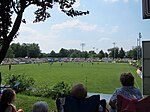West Shore (Harrisburg)
The West Shore of the Harrisburg area is a group of western suburbs of Harrisburg, Pennsylvania in proximity to the right bank of the Susquehanna River. This distinct area is located mainly in eastern Cumberland County but also in SE Perry County and far northern York County. The substantial width of the river adjacent to Harrisburg contributes to the local perception of the existence of an East Shore and a West Shore. The Patriot-News has a West Shore edition for local news and the Pennsylvania Turnpike (Interstate 76) junction with Interstate 83 located just south of New Cumberland in Fairview Township, York County is named the Harrisburg West Shore Interchange. The West Shore Farmers Market is located in Lemoyne. The West Shore School District includes municipalities in Cumberland and York Counties.
Excerpt from the Wikipedia article West Shore (Harrisburg) (License: CC BY-SA 3.0, Authors).West Shore (Harrisburg)
Plum Street,
Geographical coordinates (GPS) Address Nearby Places Show on map
Geographical coordinates (GPS)
| Latitude | Longitude |
|---|---|
| N 40.241 ° | E -76.894 ° |
Address
Plum Street 596
17043
Pennsylvania, United States
Open on Google Maps









